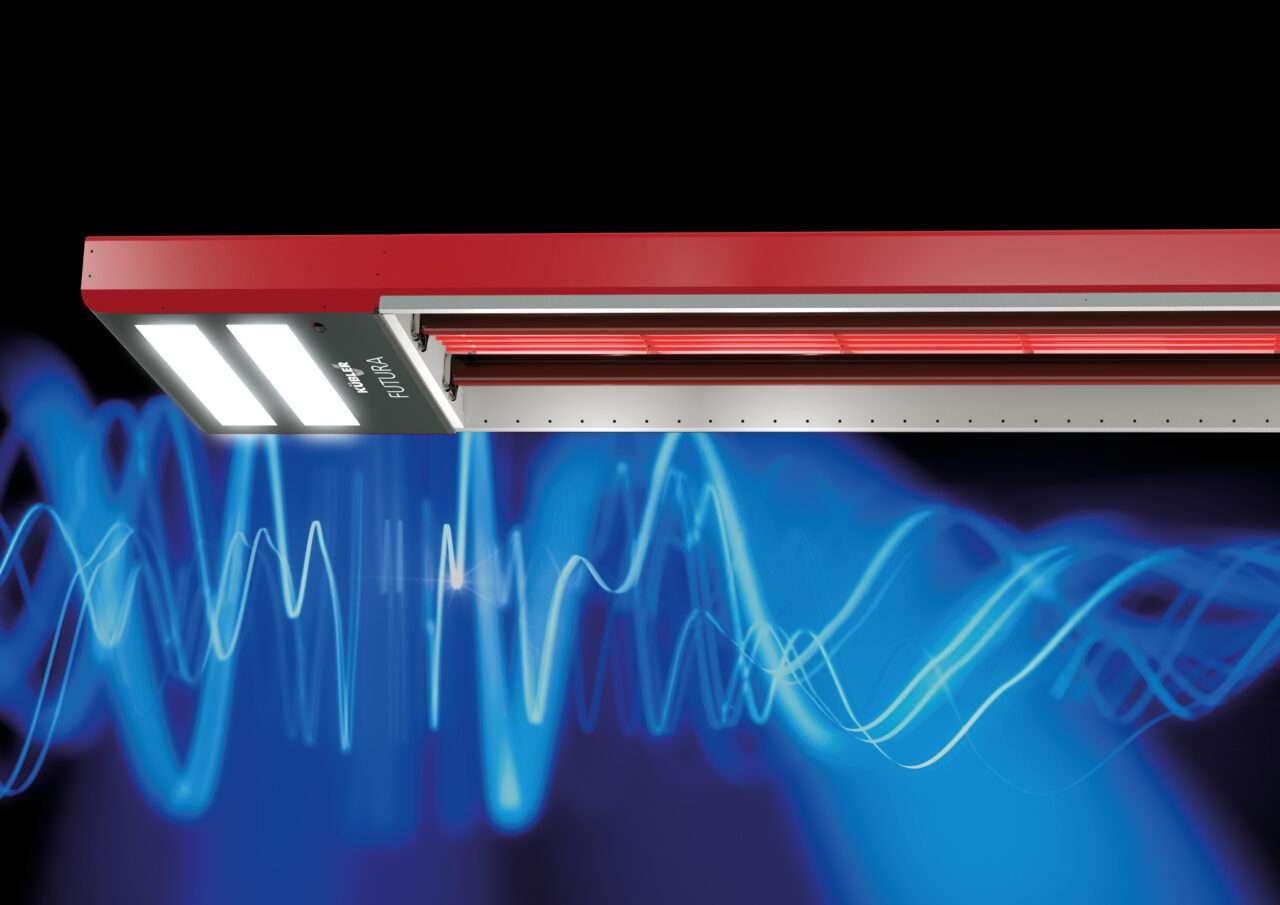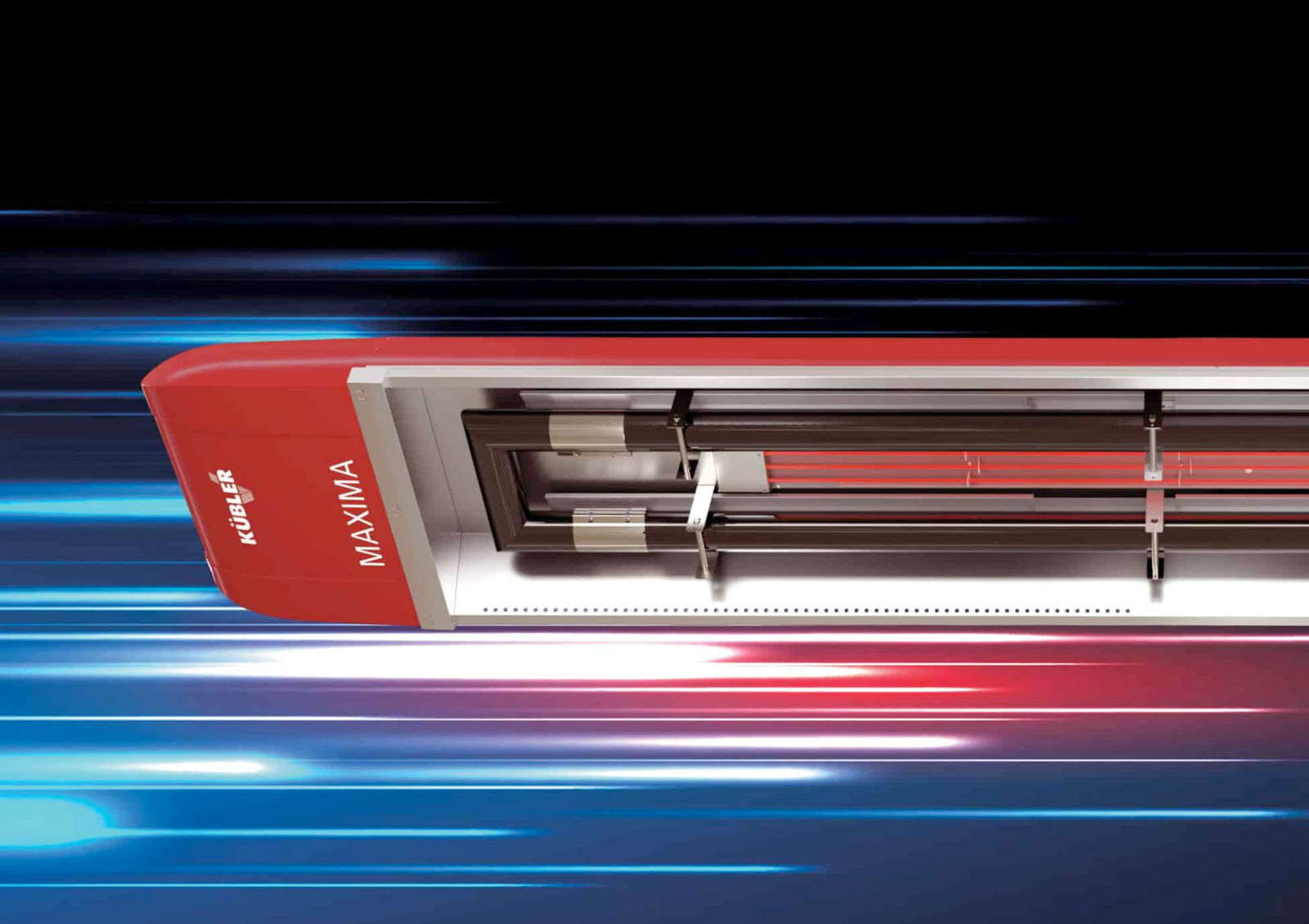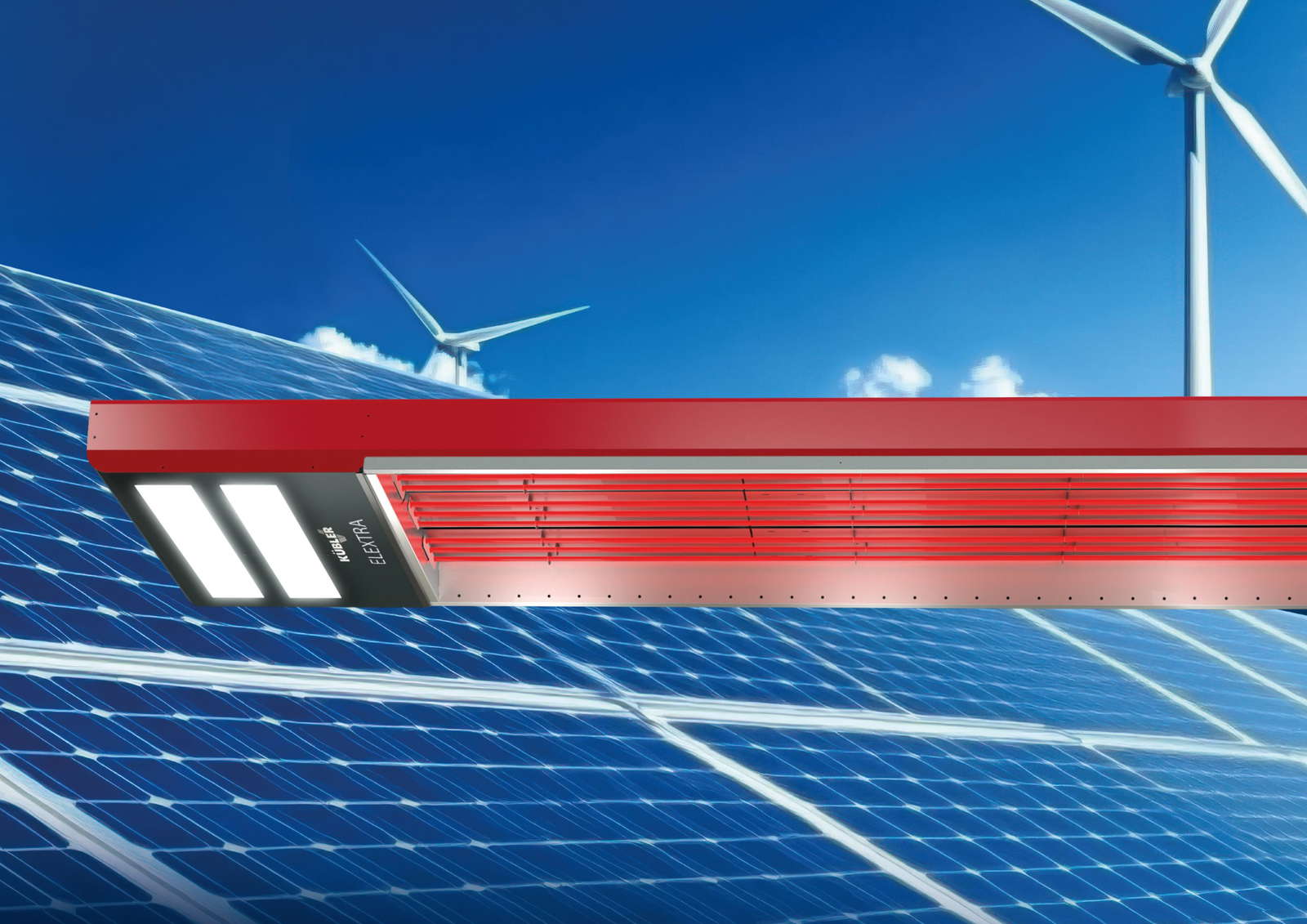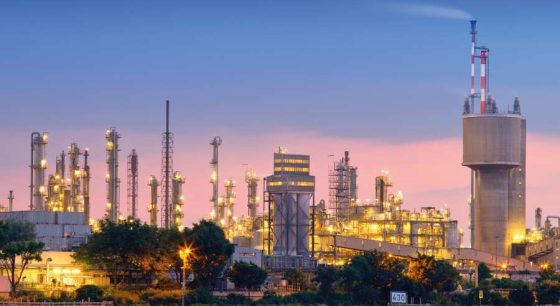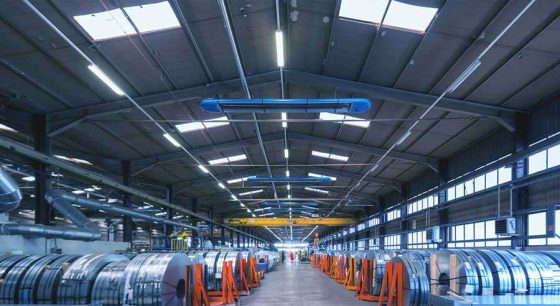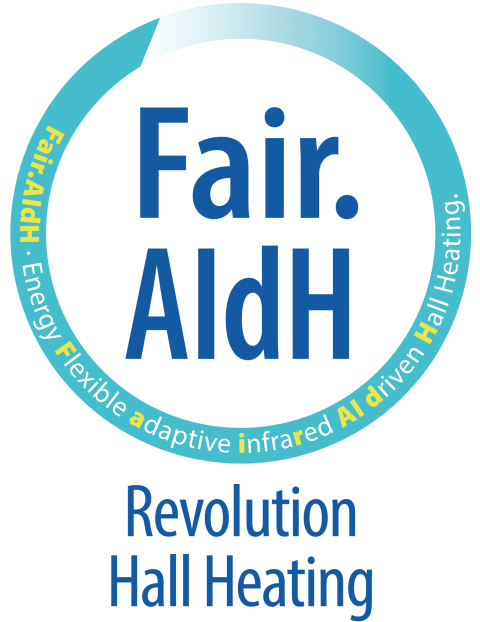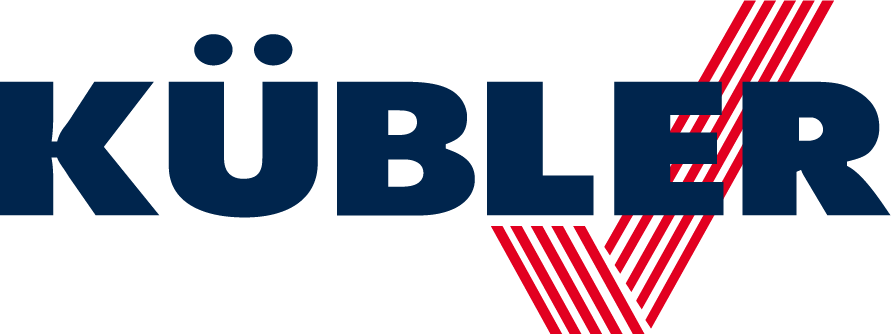Heating with infrared radiant heaters: You should know these facts!
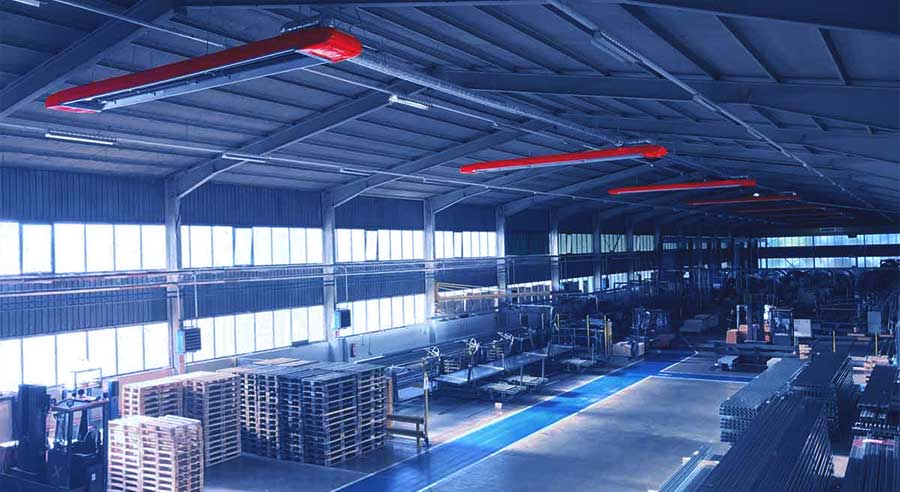
- Saving heating costs sensibly
- Increase energy efficiency
- Creating thermal comfort in the workplace
- Ensure flexibility in operations and
- Fulfill environmental protection requirements and legal requirements
Are you thinking about whether infrared radiant heaters are the right choice? Then these following facts should make your decision easier!
How infrared dark radiators work
Before we get down to the hard facts, we should first clarify two fundamental questions and clear up common misunderstandings. What are radiant heaters and what is the difference between infrared dark radiators and light radiators?
Many of the answers you will find on the Internet are unenlightening or simply nonsense. It is true that both light and dark radiators are radiant heaters, as heat is transferred almost exclusively by infrared radiation. As a rule, natural gas or liquid gas is used as the energy source. However, biogas or hydrogen, e.g. from renewable sources, also have great potential for the future.
Dark radiators use closed combustion in a pipe system. Bright spotlight work with open combustion. The main difference is therefore how the combustion gases are handled: With bright radiators, these initially remain in the hall atmosphere. For this reason, sufficient ventilation must be provided for these systems. With infrared dark radiators, the exhaust air is discharged outside via an exhaust system - without polluting the hall atmosphere. This is why the use of dark radiant heaters is the preferred choice in most applications today.
Die entstehende Wärme wird bei beiden Systemen als Infrarotstrahlen in die zu beheizenden Bereiche gelenkt. Ähnlich wie bei Sonnenstrahlen entsteht Wärme, sobald die Infrarotstrahlen auf Körper oder Gegenstände treffen. So werden u. a. der Hallenboden, die Raumfassung und die Menschen im Arbeitsbereich direkt erwärmt.
The special thing about this is that dark radiators do not heat the ambient air with their infrared radiation, but only directly heat what is actually to be heated. As a result, there is virtually no warm air that rises under the hall roof for physical reasons instead of remaining in the work area. This is precisely the decisive advantage of infrared heaters in terms of efficiency.
No hot air - no air movement
Where there's planing, there's chipping. Or a lot of dust is created. This dust is stirred up by conventional hot air heaters that are often used in halls. This is a problem in many companies, but it can easily be counteracted with infrared dark radiators. These do not heat the air and therefore cannot create draughts or stir up dust. For your employees and visitors, this means a healthy, dust-free and draught-free working atmosphere.
Infrared dark radiators heat particularly efficiently
Let's stay with hot air heating systems, which are usually used in industrial and commercial buildings. Simple physics quickly makes it clear that these are not particularly efficient for heating large halls: After all, the heated air rises straight upwards. To ensure that it is not only warm under the roof, but also in the actual usable area of the hall, it must be continuously reheated. If the hall door is constantly open or the hall is outdated and not sufficiently insulated, this results in an enormous waste of energy and money.
Infrared dark radiators, on the other hand, only heat the objects and bodies they hit, as already described. And if no warm air is generated, no warm air can escape. In addition, the operation of dark radiant heaters can be flexibly adapted to the various situations that work in halls entails by means of a correspondingly intelligent control system:
- Gate opening times
- Working hours and shift times
- Different usage zones in the hall, in which different amounts of heat are required
This means you heat particularly efficiently with infrared radiant heaters. Expressed in clear figures: they consume up to 70 % less energy compared to conventional systems. Modern infrared radiant heaters are therefore probably the most efficient heating systems currently available for industrial and commercial buildings. As a result, you not only quickly recoup the purchase costs, but also do something good for the environment.
No need to worry about GEG & Co.: even high efficiency requirements can be safely met with modern infrared dark radiators
Speaking of environmental protection: Anyone who has not taken care of efficient heating systems and other energy-saving measures in their halls in recent years is increasingly being forced into action. Because in order to achieve the goals of the 2050 climate protection plan, the legislator is calling for the economical use of energy in various ways. Important here are
- the GEG - Building Energy Act (since 01.11.2020) and
- die CO₂-Steuer (since 01.01.2021)
- der EU-ETS 2 (ab 2027
Und was Energiemanagement Zertifizierungen angeht: Wer die Audits nach der DIN EN ISO 50001 erfüllen will, muss auch hier steigende Effizienzanforderungen erfüllen.
Das GEG, welches die bisherigen komplexen Energieeinspargesetze zusammenfasst, fordert seit 2024 unter anderem die Nutzung von 65 % regenerativer Energiequellen. Dass Infrarot-Dunkelstrahler mit Gas arbeiten, scheint dem zu widersprechen. Oder?
Nein, im Gegenteil. Dieser weitverbreitete Irrtum ist aufgrund missverständlicher Kommunikation zur Gesetzgebung entstanden und sorgt immer noch für einige Verunsicherung. Fakt ist jedoch: moderne Infrarot-Dunkelstrahler wurden aufgrund ihrer hohen Energieeffizienz schon immer gesetzeskonform eingesetzt – im Neubau wie in der Sanierung. Im GEG wird diese hohe Effizienz jetzt verstärkt gewürdigt, indem dezentral beheizte Hallen mit Raumhöhen von über vier Metern von der Pflicht zum Einsatz regenerativer Energien entbunden werden, wenn eine jährliche Einsparung von 40 % und mehr nachgewiesen werden können. Zudem weist der Energieträger Gas nicht nur einen guten Primärenergiefaktor auf. Gas ist die Technologie der Zukunft mit großen Potenzialen, sobald das Thema Power-to-Gas, also die Herstellung von Wasserstoff, in großindustriellen Prozessen verfügbar sein wird. Gasbetriebene Infrarot-Dunkelstrahler bleiben also auch zukünftig ein Goldstandard zur energieeffizienten Beheizung von Hallengebäuden. Und das zahlt sich im wahrsten Sinne des Wortes aus.
Dark radiators are an investment that pays off. Right from the start.
One mistake that is made particularly frequently when planning hall heating systems is failing to see the big picture. The new devices should be as inexpensive as possible in terms of investment - and this pays off in the long term if the consumption costs are ignored. After all, a hall heating system consumes x times its investment costs over its life cycle. It is therefore important to also focus on the life cycle costs. The keyword here is: low TCO - Total Costs of Ownership. You can save (or spend!) a lot of money at the wrong end without it being really effective in the end.
So which heating system is worthwhile - even in the long term? The answer is: the heating system that best suits your usage profile and meets your economic requirements. Compared to many other systems, infrared dark radiators are characterized by low investment costs. This is confirmed by the results of a study that we carried out together with the Technical University of Kaiserslautern. Investment costs for the use of renewable energies such as a heat pump in conjunction with underfloor heating or a wood pellet stove coupled with radiant ceiling panels are between a factor of 1.8 and 4.0 - on average a factor of 3.0! - higher than with a dark radiator system with residual heat utilization.
As already mentioned, infrared radiant heaters also score highly in terms of efficiency and low annual energy requirements. The investment costs are amortized after just a few years. A dark radiant heater therefore clearly pays off in most halls.
Mit einer Infrarotheizung investieren Sie sicher in die heiztechnische Zukunft.
Infrarotheizungen können mit Gas betrieben werden. Müssen es aber nicht. Seit kurzem geht es auch regenerativ mit Energien wie Strom oder Wasserstoff. Möglich wird dies durch eine neue Technologie, die sich Fair.AIdH nennt (Energy Flexible, adaptive, infrared, AI driven, Hall heating). Diese Neuentwicklung bietet die Energieeffizienz des stärksten Dunkelstrahlers von KÜBLER und nutzt Infrarot zur Wärmeübertragung, wächst aber weit über die klassische Dunkelstrahlertechnik hinaus: anstelle von Gas wird energieflexibel mit verschiedenen Energieträgern wie PV-, Netzstrom, Biogas oder Wasserstoff geheizt – im Mix- oder Monobetrieb. Erd- oder Flüssiggas sind als Redundanzenergie nutzbar, z. B. wenn Dunkelflauten ausgeglichen werden müssen. Gesteuert wird mit intelligenter KI-gestützter Technik. Und wer will, kann seine Heizung als 2in1-System mit integrierter LED-Hallenbeleuchtung ausstatten. So werden die Kosten für Infrastruktur und Wartung nahezu halbiert und die Nachhaltigkeit der Lösung nochmals erhöht. Infrarot-Hallenheizungen mit der neuen Fair.AIdH-Technik sind z. B. die mehrfach ausgezeichnete Linie FUTURA oder FUTURA E. Es gibt mit ELEXTRA bereits aber auch eine reine strombetriebene Geräteserie für 100 % CO2-freies Heizen. Viele Hallenbetreiber dürfte es interessant sein, dass sich dank der neuen Fair.AIdH-Technik die großen Vorteile der Infrarottechnik auch weiterhin nutzen lassen. Alle Systeme mit Fair.AIdH sind GEG-konform und darauf ausgelegt, die Dekarbonisierung entlang des Transformationspfade möglichst wirtschaftlich und funktional umzusetzen.
Achieve personal and energy policy goals with dark radiators
Regardless of whether your hall is four, ten or more meters high: dark radiators are a sustainable investment that will not only increase the satisfaction and productivity of your employees, but also help you to meet energy policy targets thanks to their high efficiency. Find out more here. If you would like to talk about concrete plans now, Let's have a conversation and discuss the different requirements of your industry.
-
Back in July 2022, the BMWK published its concept paper on the amendment to the Building Energy Act (GEG), thereby not only causing hopeless uncertainty, but also preventing investment in necessary energy-efficient renovations. First things first: the amendment has not yet been passed - and it is questionable whether it will actually be passed 1:1. Because if you trust Struck's law, a law does not usually leave parliament in the form in which it was introduced.
-
The horrendous rise in energy prices, the fear of Putin stopping supplies, the demand for renewable energies to combat climate change - all of this is currently causing a great deal of uncertainty. Is it still worth investing in gas-powered industrial heating systems? The answer to this question is important. Because it determines how quickly trade and industry will make their contribution to the energy transition. And how well it will be possible to meet the future requirement of climate protection in an economically viable way.
-
Infrared hall heating in your production: How to create the right indoor climate for your productionIndoor buildings are a world of their own. Especially in winter. The high rooms pose a real challenge for anyone who wants to ensure the most pleasant working climate possible. But there are solutions - infrared hall heating, for example.
-
Whether in metalworking shops, joineries, welding shops, car dealerships or railroad companies - workshop heating systems ensure warm working conditions in the workshops when it gets cold outside. But what requirements - apart from heat generation, of course - can you place on a modern heating system today? And what do you need to pay attention to if you want your investment to continue to pay off in many years' time?
